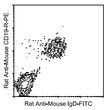Human IgD mouse monoclonal antibody, clone NI 158, FITC
| Applications | To identify the presence of IgD in human serum, other body fluids, cell and tissue substrates and to determine its concentration in techniques as direct and indirect immunofluorescence staining of cytoplasmic IgD and cell membrane IgD. General Recommended Dilutions: Histochemical Use: 1/10-1/100. |
| Reactivities | Human |
| Conjugation | FITC |






























































































































































































































































 Germany
Germany
 Japan
Japan
 United Kingdom
United Kingdom
 China
China

